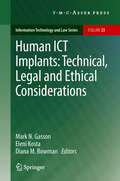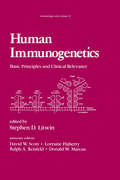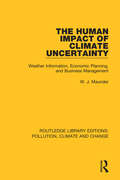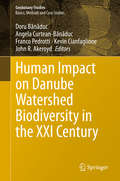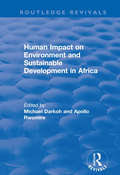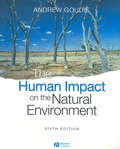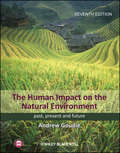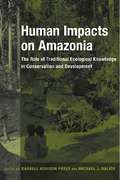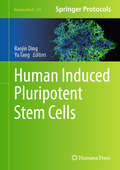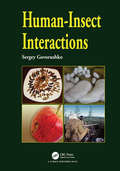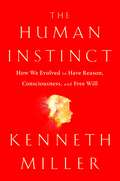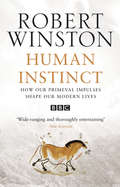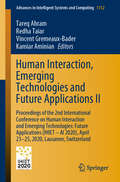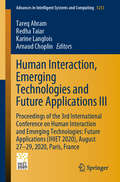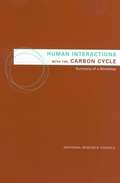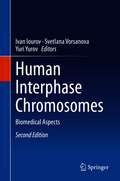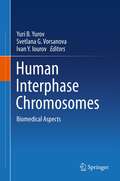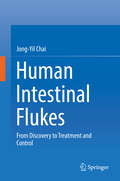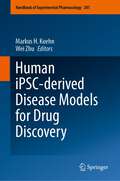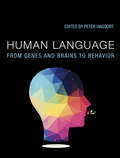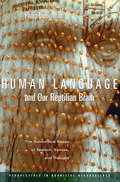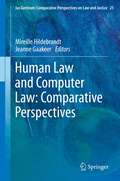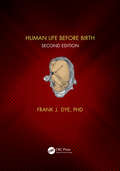- Table View
- List View
Human ICT Implants: Technical, Legal and Ethical Considerations
by Mark N. Gasson Diana M. Bowman Eleni KostaHuman information and communication technology (ICT) implants have developed for many years in a medical context. Such applications have become increasingly advanced, in some cases modifying fundamental brain function. Today, comparatively low-tech implants are being increasingly employed in non-therapeutic contexts, with applications ranging from the use of ICT implants for VIP entry into nightclubs, automated payments for goods, access to secure facilities and for those with a high risk of being kidnapped. Commercialisation and growing potential of human ICT implants have generated debate over the ethical, legal and social aspects of the technology, its products and application. Despite stakeholders calling for greater policy and legal certainty within this area, gaps have already begun to emerge between the commercial reality of human ICT implants and the current legal frameworks designed to regulate these products. This book focuses on the latest technological developments and on the legal, social and ethical implications of the use and further application of these technologies.
Human Identity and Identification
by Rebecca Gowland Tim ThompsonFew things are as interesting to us as our own bodies and, by extension, our own identities. In recent years, there has been a growing interest in the relationship between the body, environment and society. Reflecting upon these developments, this book examines the role of the body in human identification, in the forging of identities, and the ways in which it embodies our social worlds. The approach is integrative, taking a uniquely biological perspective and reflecting on current discourse in the social sciences. With particular reference to bioarchaeology and forensic science, the authors focus on the construction and categorisation of the body within scientific and popular discourse, examining its many tissues, from the outermost to the innermost, from the skin to DNA. Synthesising two, traditionally disparate, strands of research, this is a valuable contribution to research on human identification and the embodiment of identity.
Human Immunogenetics: Basic Principles and Clinical Relevance
by S. D. LitwinDelineating fundamental concepts of contemporary immunogenetics, this reference/text examines specific immunogenetic systems in terms of molecular biochemistry and immunophysiology. Covers material in diverse fields, including infectious diseases, cell biology, virology, molecular genetics. Comprise
The Human Impact of Climate Uncertainty: Weather Information, Economic Planning, and Business Management
by W. J. MaunderOriginally published in 1989, this book provides an overview of the economic dimensions of climate and human activities, and considers how the variable nature of the atmosphere must be accepted as an integral part of the management package. It discusses how climatic repercussions can hold major importance for international politics, particularly in the light of the impacts of climatic changes induced by greenhouse gases.
Human Impact on Danube Watershed Biodiversity in the XXI Century (Geobotany Studies)
by Franco Pedrotti Doru Bănăduc Angela Curtean-Bănăduc Kevin Cianfaglione John R. AkeroydThe second-longest European river after the Volga, the Danube is one of the world’s most important rivers in terms of its geographical and historical significance. In recent history, it has served as a major international waterway and numerous cities, including four capitals, have been founded on its banks. The 2826km-long Danube has a watershed measuring 801,093 km2 that is now shared between 19 countries, from its source in the Black Forest to the Black Sea, into which it pumps an average of 827 km3 of water a year. This book describes and explains key landscape values interactions (geographical, cultural and natural heritage). It also identifies the threats and various types of human impact affecting this system in all the countries of the Danube River Basin, based on the investigations and perspectives of a team of experienced naturalists, and in the context of the early 21st century, in which the human-nature relationship is still far from balanced. These studies demonstrate how biodiversity, conservation and ecological studies can help us successfully promote mutual cooperation and combine our efforts to address problems as a responsible continent.
Human Impact on Environment and Sustainable Development in Africa (Contemporary Perspectives On Developing Societies Ser.)
by Michael B.K. DarkohThis title was first published in 2003. Based on a blend of knowledge and perspectives from a variety of disciplines this volume examines the human-environment interaction in Africa, with a focus on the economic, social and political processes that generate environmental change and problems in this region. Currently there are controversies over and challenges to such concepts and issues as environment-human relationships, ecological resilience, decertification, sustainable development, globalization and North-South dialogue. This book draws upon past and present research findings to discuss these issues. It features: an examination of the characteristics, processes and patterns of environmental crises; an analysis of the principal issues and challenges facing policy makers and implementers; and the promotion of awareness of theoretical, empirical and comparative research. The volume not only seeks to answer some of the old questions, but also open up new ones for further discussion.
Human Impact on the Environment (Inspire Science, Grade 6 Integrated #Unit 4)
by Alton L. Biggs Ralph M. Feather Douglas FisherNIMAC-sourced textbook
The Human Impact on the Natural Environment: Past, Present, and Future
by Andrew S. GoudieThe new edition of this classic student text provides an up-to-date and comprehensive view of the major environmental issues facing the world today, and is an essential introduction to the past, present and future impact of humans on Earth. Explores the impact of humans upon vegetation, animals, soils, water, landforms, and the atmosphere. Updated extensively, with many new figures and up-to-date statistics. Four completely new chapters explore the ways in which global climate change may have an impact on Earth in the future. A new design makes the text even more accessible and easy to use. Visit www.blackwellpublishing.com/humanimpact to access the artwork from the book.
The Human Impact on the Natural Environment: Past, Present, and Future
by Andrew S. GoudieThe seventh edition of this classic student text explores the multitude of impacts that humans have had over time upon vegetation, animals, soils, water, landforms and the atmosphere. It also looks into the future and considers the ways in which climate changes and modifications in land cover may change the environment in coming decades. Extensively re-written, it contains many new statistical tables, figures, and references. It is essential reading for undergraduates in geography and environmental science, and for those who want a thorough, wide-ranging and balanced overview of the impacts of humans upon natural processes and systems from the Stone Age to the Anthropocene and who wish to understand the major environmental issues that concern the human race at the present time. Additional resources for this book can be found at: www.wiley.com/go/goudiehumanimpact.
Human Impacts on Amazonia: The Role of Traditional Ecological Knowledge in Conservation and Development (Biology and Resource Management Series)
by Darrell Posey Michael BalickFrom the pre-Columbian era to the present, native Amazonians have shaped the land around them, emphasizing utilization, conservation, and sustainability. These priorities stand in stark contrast to colonial and contemporary exploitation of Amazonia by outside interests. With essays from environmental scientists, botanists, and anthropologists, this volume explores the various effects of human development on Amazonia. The contributors argue that by protecting and drawing on local knowledge and values, further environmental ruin can be avoided.
Human Induced Pluripotent Stem Cells (Neuromethods #210)
by Baojin Ding Yu TangThis volume explores the latest developments in the field and showcases the vast potential of human induced pluripotent stem cells (hiPSCs) in advancing neuroscience research. The chapters in this book are organized into three parts. Part One describes the generation, characterization, and validation of hiPSCs using different methodologies from various resources. Part Two focuses on techniques for genome editing of hiPSCs. Part Three covers various hiPSC applications in neuroscience research and strategies for analyzing hiPSC-based model systems. These applications include the generation of neural subtypes, glial cells, and skeletal muscles; assembling co-culture systems to prepare highly pure neurons at late maturation stages; measuring nuclear transport of proteins and transcripts in cultured neurons; and generating brain organoids. In the Neuromethods series style, chapters include the kind of detail and key advice from specialists needed to achieve successful results in your laboratory. Cutting-edge and comprehensive, Human Induced Pluripotent Stem Cells is a valuable resource for researchers and students in neuroscience, neurology, stem cell biology, and other related fields.
Human-Insect Interactions
by Sergey GovorushkoThis book presents a 360-degree picture of the world of insects and explores how their existence affects our lives: the "good, bad, and ugly" aspects of their interactions with humankind. It provides a lucid introductory text for beginning undergraduate students in the life sciences, particularly those pursuing beginner courses in entomology, agriculture, and botany.
The Human Instinct: How We Evolved to Have Reason, Consciousness, and Free Will
by Kenneth R. MillerA radical, optimistic exploration of how humans evolved to develop reason, consciousness, and free will.Lately, the most passionate advocates of the theory of evolution seem to present it as bad news. Scientists such as Richard Dawkins, Lawrence Krauss, and Sam Harris tell us that our most intimate actions, thoughts, and values are mere byproducts of thousands of generations of mindless adaptation. We are just one species among multitudes, and therefore no more significant than any other living creature. Now comes Brown University biologist Kenneth R. Miller to make the case that this view betrays a gross misunderstanding of evolution. Natural selection surely explains how our bodies and brains were shaped, but Miller argues that it’s not a social or cultural theory of everything. In The Human Instinct, he rejects the idea that our biological heritage means that human thought, action, and imagination are pre-determined, describing instead the trajectory that ultimately gave us reason, consciousness and free will. A proper understanding of evolution, he says, reveals humankind in its glorious uniqueness—one foot planted firmly among all of the creatures we’ve evolved alongside, and the other in the special place of self-awareness and understanding that we alone occupy in the universe. Equal parts natural science and philosophy, The Human Instinct is a moving and powerful celebration of what it means to be human.
Human Instinct
by Professor Lord Robert WinstonFrom caveman to modern man ...Few people doubt that humans are descended from the apes; fewer still consider, let alone accept, the psychological implications. But in truth, man not only looks, moves and breathes like an ape, he also thinks like one. Sexual drive, survival, competition, aggression - all of our impulses are driven by our human instincts. They explain why a happily married man will fantasize about the pretty, slim, young woman sitting across from him in the tube and why thousands of people spend their week entirely focused on whether their team will win their next crucial match. But how well do our instincts equip us for the twenty-first century? Do they help or hinder us as we deal with large anonymous cities, stressful careers, relationships and the battle of the sexes? In this fascinating book, Robert Winston takes us on a journey deep into the human mind. Along the way he takes a very personal look at the relationship between science and religion and explores those very instincts that make us human.
Human Interaction, Emerging Technologies and Future Applications II: Proceedings of the 2nd International Conference on Human Interaction and Emerging Technologies: Future Applications (IHIET – AI 2020), April 23-25, 2020, Lausanne, Switzerland (Advances in Intelligent Systems and Computing #1152)
by Tareq Ahram Redha Taiar Vincent Gremeaux-Bader Kamiar AminianThis book reports on research and developments in human-technology interaction. A special emphasis is given to human-computer interaction, and its implementation for a wide range of purposes such as healthcare, aerospace, telecommunication, and education, among others. The human aspects are analyzed in detail. Timely studies on human-centered design, wearable technologies, social and affective computing, augmented, virtual and mixed reality simulation, human rehabilitation and biomechanics represent the core of the book. Emerging technology applications in business, security, and infrastructure are also critically examined, thus offering a timely, scientifically-grounded, but also professionally-oriented snapshot of the current state of the field. The book is based on contributions presented at the 2nd International Conference on Human Interaction and Emerging Technologies: Future Applications, IHIET-AI 2020, held on April 23-25, in Lausanne, Switzerland. It offers a timely survey and a practice-oriented reference guide to researchers and professionals dealing with design and/or management of the new generation of service systems.
Human Interaction, Emerging Technologies and Future Applications III: Proceedings of the 3rd International Conference on Human Interaction and Emerging Technologies: Future Applications (IHIET 2020), August 27-29, 2020, Paris, France (Advances in Intelligent Systems and Computing #1253)
by Tareq Ahram Redha Taiar Arnaud Choplin Karine LangloisThis book reports on research and developments in human-technology interaction. A special emphasis is given to human-computer interaction, and its implementation for a wide range of purposes such as healthcare, aerospace, telecommunication, and education, among others. The human aspects are analyzed in detail. Timely studies on human-centered design, wearable technologies, social and affective computing, augmented, virtual and mixed reality simulation, human rehabilitation and biomechanics represent the core of the book. Emerging technology applications in business, security, and infrastructure are also critically examined, thus offering a timely, scientifically-grounded, but also professionally-oriented snapshot of the current state of the field. The book is based on contributions presented at the 3rd International Conference on Human Interaction and Emerging Technologies: Future Applications, IHIET 2020, held on August 27-29, 2020. It offers a timely survey and a practice-oriented reference guide to researchers and professionals dealing with design and/or management of the new generation of service systems.
Human Interactions with the Carbon Cycle: Summary of a Workshop
by Paul C. SternThe results of a November 2001 workshop on human interactions with the carbon cycle are summarized here, focusing on the future of fossil fuel consumption, carbon implications of future land use/land cover transformation, and modeling human interactions with the carbon cycle. There is no subject index. Annotation (c)2003 Book News, Inc. , Portland, OR (booknews. com)
Human Interphase Chromosomes: Biomedical Aspects
by Ivan Iourov Svetlana Vorsanova Yuri YurovThis second edition focuses on the study of human interphase chromosomes and its relation to health and disease. Orchestrated organization and behavior of the human genome in interphase nuclei at chromosomal level has been repeatedly shown to play a significant role in almost all basic biological processes involved in the processing and inheritance of genetic information within and between species. Accordingly, post-genomic bioscience appeals to basic and applied studies of interphase nuclei genetics and genomics with special attention to interphase chromosome behavior in health and disease. Additionally, elucidating the role of interphase chromosome behavior during development, chromosome/DNA replication, DNA reparation opens new horizons for basic and applied bioscience Studies of interphase nuclei have an appreciable impact on different areas of biomedical sciences such as cell biology, neurobiology, cancer research, developmental biology, epigenetics, cytogenetics, and medical genetics, as a whole. Moreover, development of innovative and emergent technologies to analyze interphase nuclei are closely associated with application of these techniques in diagnostic and research practices to solve reproductive problems (including infertility and spontaneous abortions), to investigate congenital malformations (including those produced by aneuploidy and other chromosome abnormalities); genetic diseases (including cardiac, immune, neurological and psychiatric diseases), and cancer. This second edition serves as a source of updated valuable information and promising ideas for a wide audience of professionals in biomedicine including researchers, scientists, and healthcare professionals in human genetics, cytogenetics, and developmental biology.
Human Interphase Chromosomes
by Svetlana G. Vorsanova Ivan Y. Iourov Yuri B. YurovThis title will focus on the study of human interphase chromosomes and its relation to health and disease. Orchestrated organization and human genome function in interphase nuclei at the chromosomal level have been repeatedly shown to play a significant role in a variety of basic biological processes involved in realization and inheritance of genetic information within and between species. Current biomedical sciences of post-genomic era refocus basic and applied studies of interphase nuclei genetics and genomics with special attention to interphase chromosome behavior in health and disease. Additionally, related processes are a target of studies elucidating the role of interphase chromosome behavior during development, chromosome/DNA replication, DNA reparation etc. Studies of interphase nuclei have an appreciable impact on different areas of biomedical sciences such as cell biology, neurobiology, cancer research, developmental biology, epigenetics, cytogenetics, and medical genetics, as a whole. Moreover, development of innovative and emergent technologies to analyze interphase nuclei are closely associated with application of these techniques in clinical, diagnostic and research practice to solve reproductive problems (including infertility and spontaneous abortions), to investigate congenital malformations (including those produced by aneuploidy and other chromosome abnormalities); genetic diseases (including cardiac, immune, neurological and psychiatric diseases), and cancer. This title will serve as a source of new valuable information and promising ideas for a wide audience of professionals in biomedicine including researchers, scientists, and healthcare professionals in human genetics, cytogenetics, and developmental biology.
Human Intestinal Flukes: From Discovery to Treatment and Control
by Jong-Yil ChaiThis book provides up-to-date information on the characteristics of each species of intestinal fluke found in humans and on the management of infections caused by these trematodes. Biology, epidemiology, host-parasite relationships, pathogenicity, clinical aspects, diagnosis, and treatment are all reviewed in detail. The zoonotic intestinal flukes comprise 38 genera belonging to 16 families. They are morphologically diverse and each species has a characteristic life cycle and geographical distribution. Intestinal fluke infections are commonly considered as tropical endemic diseases in Asian countries, where 6 million people are infected, but the geographical limits and populations at risk are expanding and changing owing to a range of factors, including growing international markets, improved transportation systems, changes in eating habits, demographic trends, and climate change. While the pathogenicity of intestinal flukes is generally mild, the impact in immunocompromised individuals requires clarification and some diagnostic problems remain to be solved. In exploring all aspects of human intestinal fluke infections, this book will be invaluable for clinicians and researchers alike.
Human iPSC-derived Disease Models for Drug Discovery (Handbook of Experimental Pharmacology #281)
by Markus H. Kuehn Wei ZhuSince their development a decade ago, human induced pluripotent stem cells (iPSC) have revolutionized the study of human disease, given rise to regenerative medicine technologies, and provided exceptional opportunities for pharmacologic research. These cells provide an essentially unlimited supply of cell types that are difficult to obtain from patients, such as neurons or cardiomyocytes, or are difficult to maintain in primary cell culture. iPSC can be obtained from patients afflicted with a particular disease but, in combination with recently developed gene editing techniques, can also be modified to generate disease models. Moreover, the new techniques of 3 Dimensional printing and materials science facilitate the generation of organoids that can mirror organs under disease conditions. These properties make iPSC powerful tools to study how diseases develop and how they may be treated. In addition, iPSC can also be used to treat conditions in which the target cell population has been lost and such regenerative approaches hold great promise for currently untreatable diseases, including cardiac failure or photoreceptor degenerations.
Human Language: From Genes and Brains to Behavior (The\mit Press Ser.)
by Peter HagoortA unique overview of the human language faculty at all levels of organization.Language is not only one of the most complex cognitive functions that we command, it is also the aspect of the mind that makes us uniquely human. Research suggests that the human brain exhibits a language readiness not found in the brains of other species. This volume brings together contributions from a range of fields to examine humans' language capacity from multiple perspectives, analyzing it at genetic, neurobiological, psychological, and linguistic levels.In recent decades, advances in computational modeling, neuroimaging, and genetic sequencing have made possible new approaches to the study of language, and the contributors draw on these developments. The book examines cognitive architectures, investigating the functional organization of the major language skills; learning and development trajectories, summarizing the current understanding of the steps and neurocognitive mechanisms in language processing; evolutionary and other preconditions for communication by means of natural language; computational tools for modeling language; cognitive neuroscientific methods that allow observations of the human brain in action, including fMRI, EEG/MEG, and others; the neural infrastructure of language capacity; the genome's role in building and maintaining the language-ready brain; and insights from studying such language-relevant behaviors in nonhuman animals as birdsong and primate vocalization.Section editorsChristian F. Beckmann, Carel ten Cate, Simon E. Fisher, Peter Hagoort, Evan Kidd, Stephen C. Levinson, James M. McQueen, Antje S. Meyer, David Poeppel, Caroline F. Rowland, Constance Scharff, Ivan Toni, Willem Zuidema
Human Language and Our Reptilian Brain: The Subcortical Bases of Speech, Syntax, and Thought (Perspectives in Cognitive Neuroscience)
by Philip LiebermanThis book is an entry into the fierce current debate among psycholinguists, neuroscientists, and evolutionary theorists about the nature and origins of human language. A prominent neuroscientist here takes up the Darwinian case, using data seldom considered by psycholinguists and neurolinguists to argue that human language--though more sophisticated than all other forms of animal communication--is not a qualitatively different ability from all forms of animal communication, does not require a quantum evolutionary leap to explain it, and is not unified in a single "language instinct." Using clinical evidence from speech-impaired patients, functional neuroimaging, and evolutionary biology to make his case, Philip Lieberman contends that human language is not a single separate module but a functional neurological system made up of many separate abilities. Language remains as it began, Lieberman argues: a device for coping with the world. But in a blow to human narcissism, he makes the case that this most remarkable human ability is a by-product of our remote reptilian ancestors' abilities to dodge hazards, seize opportunities, and live to see another day.
Human Law and Computer Law: Comparative Perspectives
by Jeanne Gaakeer Mireille HildebrandtThe focus of this book is on the epistemological and hermeneutic implications of data science and artificial intelligence for democracy and the Rule of Law. How do the normative effects of automated decision systems or the interventions of robotic fellow 'beings' compare to the legal effect of written and unwritten law? To investigate these questions the book brings together two disciplinary perspectives rarely combined within the framework of one volume. One starts from the perspective of 'code and law' and the other develops from the domain of 'law and literature'. Integrating original analyses of relevant novels or films, the authors discuss how computational technologies challenge traditional forms of legal thought and affect the regulation of human behavior. Thus, pertinent questions are raised about the theoretical assumptions underlying both scientific and legal practice.
Human Life Before Birth, Second Edition
by Frank DyeThis textbook presents essential and accessible information about human embryology including practical information on human health issues and recent advances in human reproductive technology. Starting with biological basics of cell anatomy and fertilization, the author moves through the development of specific organs and systems, before addressing social issues associated with embryology. Each chapter includes specific objectives, general background, study questions, and questions to inspire critical thinking. Human Life Before Birth also contains two appendices and a full glossary of terms covered in the text. Clinicians and researchers in this field will find this volume indispensable. Key selling features: Explores all the developmental and embryological events that occur in human emryonic and fetal life Reviews basic cell biology, genetics, and reproduction focusing entirely on humans Summarizes the development of various anatomical systems Examines common birth defects and sexually transmitted diseases including emerging concerns such as Zika Documents assisted fertilization technologies and various cultural aspects of reproduction
